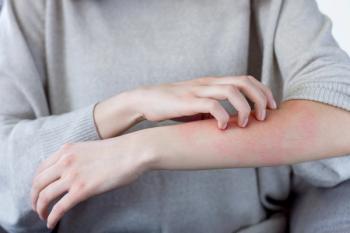
As-Needed Use of Opzelura Can Control Atopic Dermatitis
After initial treatment, Opzelura used on an as-needed basis was able to control symptoms of atopic dermatitis and helped patients sleep, according to a poster presented at the annual dermatology meeting.
Atopic dermatitis is a chronic skin disease affecting more than 21 million people aged 12 years and older in the United States. Quality of life in patients with atopic dermatitis can be reduced because of inflammation and itch.
Incyte’s Opzelura is a topical formulation of ruxolitinib, an inhibitor of JAK1 and JAK2. The FDA approved the treatment in September 2021 to treat mild-to-moderate atopic dermatitis in patients 12 years of age and older. The FDA approval was based on data from two phase 3 studies (TRuE-AD1 and TRuE-AD 2) evaluating the safety and efficacy of Opzelura in more than 1,200 adolescents and adults. Results from the studies showed patients experienced significantly clearer skin and itch reduction when treated with Opzelura cream 1.5% twice daily, compared with a non-medicated cream. Significantly more patients treated with Opzelura experienced a clinically meaningful reduction in itch from baseline at Week 8.
Led by Andrew Blauvelt, M.D., MBA, a board-certified dermatologist and investigator at Oregon Medical Research Center, investigators wanted to evaluate long-term maintenance of disease and symptom control when using ruxolitinib cream as needed. They conducted an analysis of the long-term safety extension from the two phase 3 studies. Patients initially randomized to Opzelura cream remained on their regimen for the 44-week long-term safety period.
Of 1,249 randomized patients, 1,072 (85.8%) continued into the long-term safety period; 837 (67.0%) who applied ruxolitinib cream since day 1 were evaluated for disease and symptom control in the long-term safety period. A majority completed the long-term safety period, with 11 (1.3%) discontinuing due to adverse events and 15 (1.8%) discontinuing due to lack of efficacy.
The majority of patients maintained or demonstrated improvements in symptom control of itch between assessments. The mean cumulative number of days with no treatment due to lesion clearance was 116.5 and 133.8 days with 0.75% ruxolitinib cream and 1.5% ruxolitinib cream, respectively
The majority of patients maintained or demonstrated improvements in sleep between assessments. Sleep disturbance for 0 days in the past week was reported by 64.9% applying the 0.75% ruxolitinib cream at week 8 and 74.5% at week 52. Of patients using the 1.5 ruxolitinib, 71.8% reported no days of sleep disturbance at week 8 and in 74.5% at week 52. Ruxolitinib cream was well-tolerated during 52-week study.
The study was funded by Incyte.
Newsletter
Get the latest industry news, event updates, and more from Managed healthcare Executive.





















































